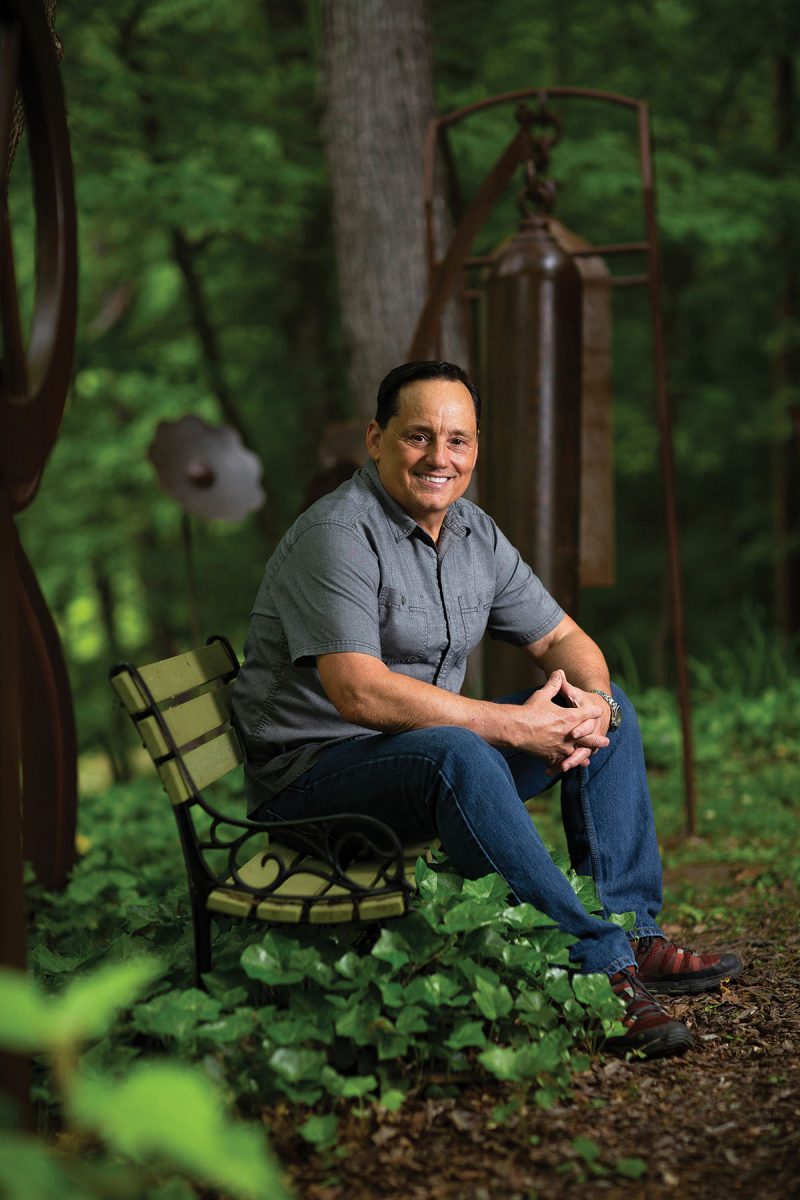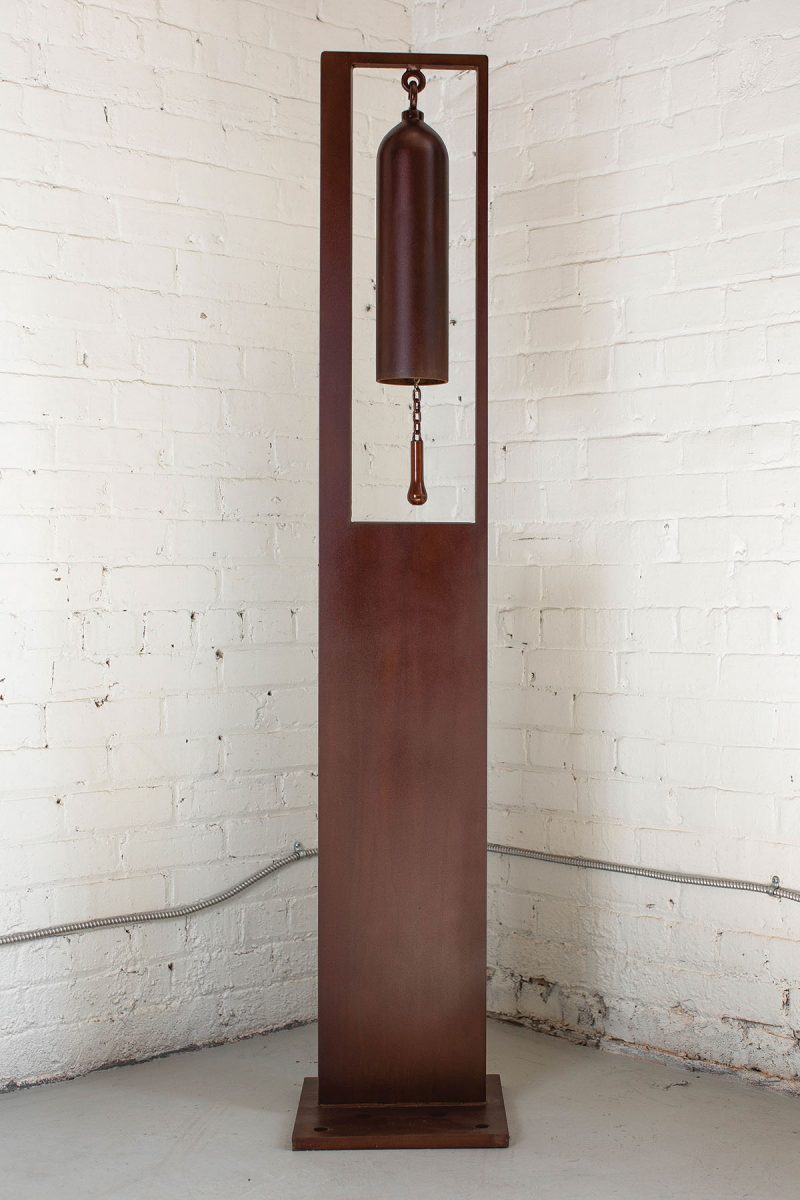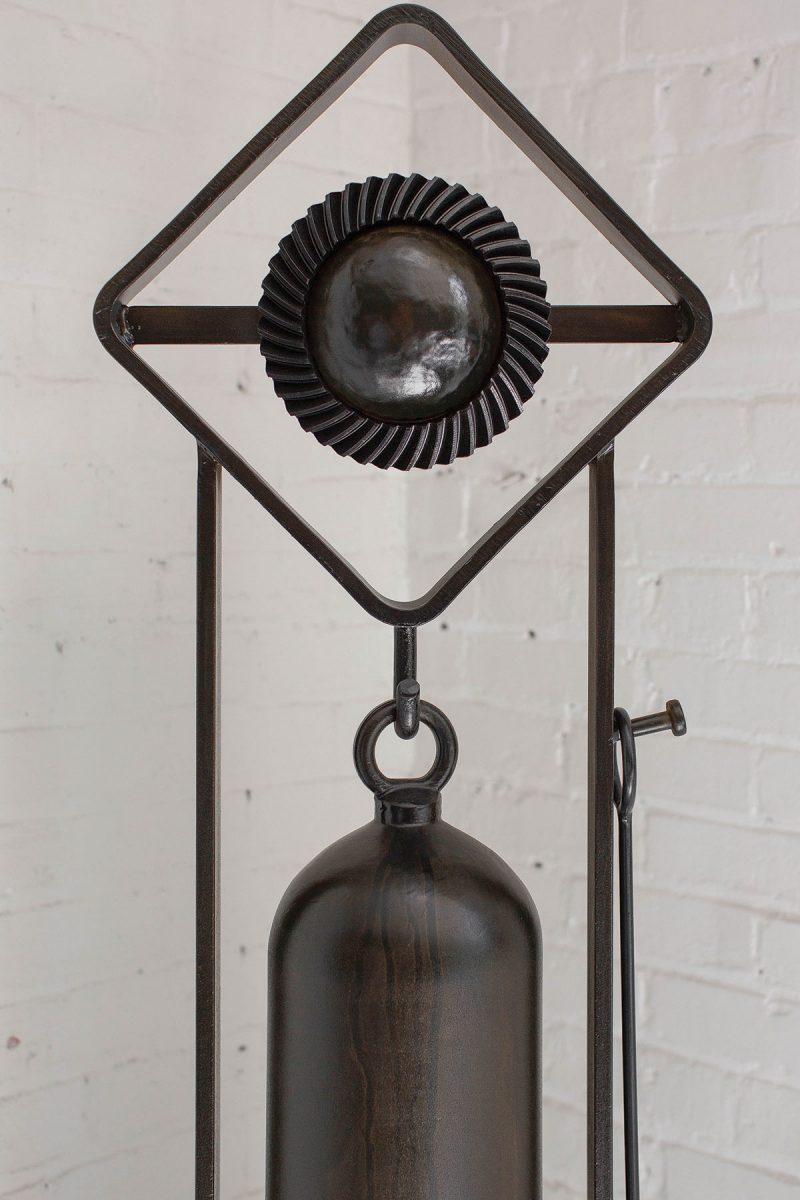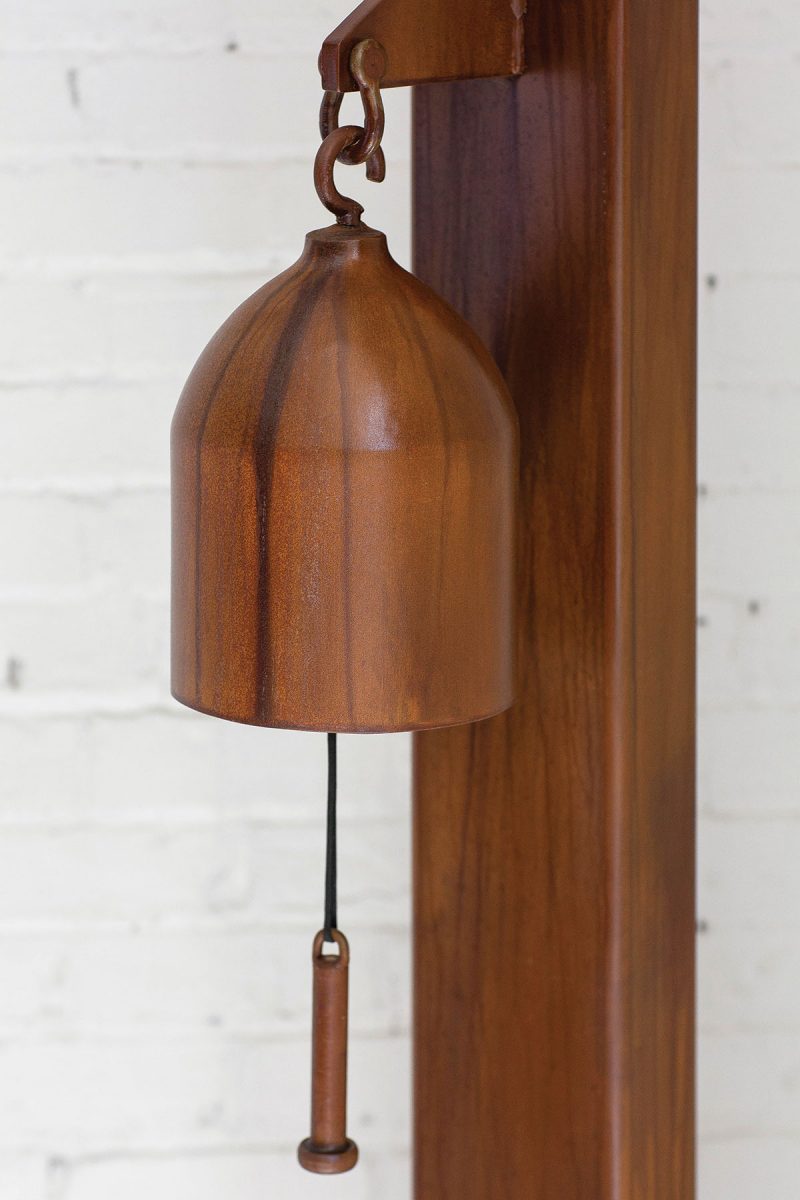
Portrait by Colby Rabon
Asheville offers many charms for the newly arrived, from its enfolding natural beauty to its distinctive architectural fabric. But the first thing that metal sculptor Ray Charnell noticed, when he and his wife chose the area as their new home in 1996, was that everyone seemed to be making something. “People were crafting things everywhere,” Charnell remembers. “It was exciting, and I wanted to be part of that.”
Particularly eye opening was a visit to the biannual Craft Fair of the Southern Highlands at the Civic Center in downtown Asheville (now Harrah’s Cherokee Center in the same location), where Charnell encountered Bea Hensley, a locally admired Spruce Pine blacksmith who, besides making utilitarian items and decorative objects, entertained the crowds by making music with his anvil and hammer.
Charnell was hooked. Now, more than 25 years later, he has a flourishing metal-art studio and has become especially sought after for his handmade bells and gongs crafted from salvaged industrial gas tanks.
The artist was no stranger to metal, having learned welding as a high schooler working afternoons and weekends at an oil-company depot in Florida, and later on the company’s tugboats, where he plied Miami’s harbor, docking and refueling cruise ships and freighters.
“When you work on a boat, you must learn to be very hands on,” he points out. “If something needs doing, you figure it out and do it. It was 14 days on and 14 days off, 12 hours a day.” After marrying and deciding to seek a more settled home life in a cooler climate, Charnell and his wife decamped for the mountains of East Tennessee, and eventually his fateful blacksmithing encounter in Asheville.

Courses at Haywood Community College’s hand-wrought-metals curriculum, part of the school’s Professional Crafts Program, expanded his welding skills from traditional blacksmithing to more artistically oriented sculpture. “Blacksmithing is a rare art these days,” Charnell says. “I do use it to add ornamental features to my pieces, like leaves and flowers, and to form metal to add pleasing shapes to my work.”
His output these days includes not only the imaginatively framed bells and gongs, but large abstract and floral outdoor sculptures, as well as smaller pieces for indoor display, all formed from steel. His more abstract pieces use basic geometric forms in creative ways, inspired in part by the work of the noted Vermont metalworker David Smith (1906-1965).
“David’s use of negative space is very influencing and can be seen on many of my collage pieces,” Charnell notes. He also credits the influence of another favorite, modern master Alexander Calder and his signature, colorfully painted mobiles: “When I paint my pieces, it’s always Calder Red.”
But it’s the bells that seem to encourage viewers to interact. He made his first one ten years ago, when he found a small discarded oxygen tank at a scrap yard. Slicing off its lower half while removing the valves and grinding the surface down to a smooth finish, Charnell brought the bell to Woolworth Walk gallery downtown to sell. Soon after, the gallery’s manager mentioned that the bell was drawing considerable attention, and the sculptor went to investigate. “I decided to observe a little as people walked by it,” he recalls. “It was getting a lot of ringing [from] kids of all ages.”
A decade later, Charnell’s bells and gongs have proliferated in gardens, on porches, and displayed indoors, all hung within ornamental stands made from the same recycled steel Charnell has delivered to his studio, sometimes in lots of a hundred pounds or more. Many of the stands incorporate the detritus of industrial production like gears, cranks, and bits of farm machinery that the sculptor finds at antique shops — even salvage from a 19th-century shipwreck.

Photo by Colby Rabon
But the tone of each bell depends more on its size, from the pleasant tinkle of a small specimen to the deep resonance of Charnell’s largest bell to date, at four feet long. (Hung in a seven-foot-tall stand, it now graces a home in San Jose, California.)
His growing body of work all stems from that first Craft Fair encounter so many years ago. “I could picture the endless possibilities,” he recalls of his discovery, “created by the flexing and reorientation of metal objects that I find. I was very happy to discover that I could create recycled art that is aesthetically pleasing and fun, too.”
Asheville offers many charms for the newly arrived, from its enfolding natural beauty to its distinctive architectural fabric. But the first thing that metal sculptor Ray Charnell noticed, when he and his wife chose the area as their new home in 1996, was that everyone seemed to be making something. “People were crafting things everywhere,” Charnell remembers. “It was exciting, and I wanted to be part of that.”
Particularly eye opening was a visit to the biannual Craft Fair of the Southern Highlands at the Civic Center in downtown Asheville (now Harrah’s Cherokee Center in the same location), where Charnell encountered Bea Hensley, a locally admired Spruce Pine blacksmith who, besides making utilitarian items and decorative objects, entertained the crowds by making music with his anvil and hammer.
Charnell was hooked. Now, more than 25 years later, he has a flourishing metal-art studio and has become especially sought after for his handmade bells and gongs crafted from salvaged industrial gas tanks.

The artist was no stranger to metal, having learned welding as a high schooler working afternoons and weekends at an oil-company depot in Florida, and later on the company’s tugboats, where he plied Miami’s harbor, docking and refueling cruise ships and freighters.
“When you work on a boat, you must learn to be very hands on,” he points out. “If something needs doing, you figure it out and do it. It was 14 days on and 14 days off, 12 hours a day.” After marrying and deciding to seek a more settled home life in a cooler climate, Charnell and his wife decamped for the mountains of East Tennessee, and eventually his fateful blacksmithing encounter in Asheville.
Courses at Haywood Community College’s hand-wrought-metals curriculum, part of the school’s Professional Crafts Program, expanded his welding skills from traditional blacksmithing to more artistically oriented sculpture. “Blacksmithing is a rare art these days,” Charnell says. “I do use it to add ornamental features to my pieces, like leaves and flowers, and to form metal to add pleasing shapes to my work.”
His output these days includes not only the imaginatively framed bells and gongs, but large abstract and floral outdoor sculptures, as well as smaller pieces for indoor display, all formed from steel. His more abstract pieces use basic geometric forms in creative ways, inspired in part by the work of the noted Vermont metalworker David Smith (1906-1965).
“David’s use of negative space is very influencing and can be seen on many of my collage pieces,” Charnell notes. He also credits the influence of another favorite, modern master Alexander Calder and his signature, colorfully painted mobiles: “When I paint my pieces, it’s always Calder Red.”
But it’s the bells that seem to encourage viewers to interact. He made his first one ten years ago, when he found a small discarded oxygen tank at a scrap yard. Slicing off its lower half while removing the valves and grinding the surface down to a smooth finish, Charnell brought the bell to Woolworth Walk gallery downtown to sell. Soon after, the gallery’s manager mentioned that the bell was drawing considerable attention, and the sculptor went to investigate. “I decided to observe a little as people walked by it,” he recalls. “It was getting a lot of ringing [from] kids of all ages.”
A decade later, Charnell’s bells and gongs have proliferated in gardens, on porches, and displayed indoors, all hung within ornamental stands made from the same recycled steel Charnell has delivered to his studio, sometimes in lots of a hundred pounds or more. Many of the stands incorporate the detritus of industrial production like gears, cranks, and bits of farm machinery that the sculptor finds at antique shops — even salvage from a 19th-century shipwreck.
But the tone of each bell depends more on its size, from the pleasant tinkle of a small specimen to the deep resonance of Charnell’s largest bell to date, at four feet long. (Hung in a seven-foot-tall stand, it now graces a home in San Jose, California.)
His growing body of work all stems from that first Craft Fair encounter so many years ago. “I could picture the endless possibilities,” he recalls of his discovery, “created by the flexing and reorientation of metal objects that I find. I was very happy to discover that I could create recycled art that is aesthetically pleasing and fun, too.”
Ray Charnell, Asheville. The sculptor’s metal pieces are sold at Woolworth Walk (25 Haywood St. downtown, woolworthwalk.com) and at Philip DeAngelo Studios (115 Roberts St. in the River Arts District, philipdeangeloart.com). For more information, see raycharnell.com.

A great article and richly deserved! Your pieces are exquisite!